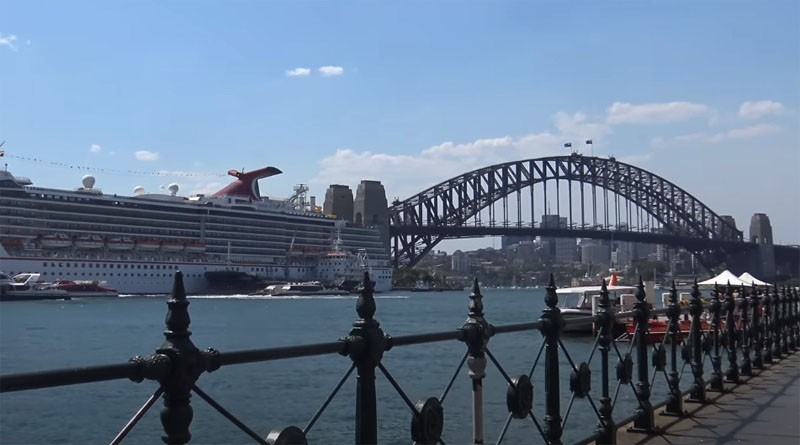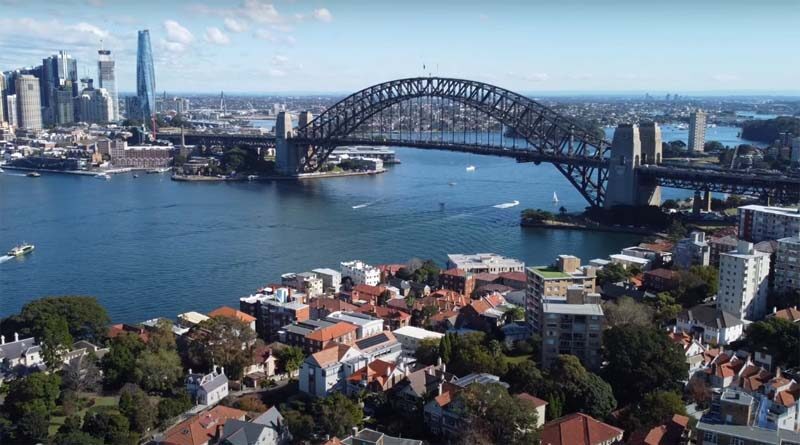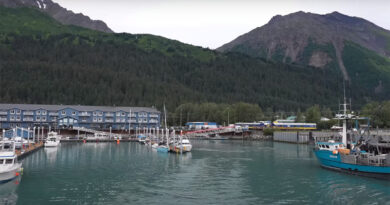Sydney Harbour Bridge, Australia
Written by Kelsey F.
Last update: February 2, 2024
| Overview | Facts | History | Surrounding Area | Museum | Bridge climb Sidney | Seven secrets |
1. Overview:
One of the most famous landmarks in the world is the Sydney Harbour Bridge. The first opening of Sydney Harbour Bridge was on March 19, 1932, a lot has changed. Today, as Australia’s most beloved icon turns 90, we take a look back at some of our favourite photos. It traverses one of the most effective beautiful harbours on the planet and is not just the largest steel arch bridge in the world. Locals affectionately refer to it as “the Coathanger,” and it is an essential component of the city; you can walk, bike, or even climb to the top for breathtaking vistas.
Construction of the famous bridge began in 1932 and lasted eight years. Six million hand-driven rivets and 53,000 tonnes of steel go into its construction. On August 19, 1930, at 10 p.m., the two steel parts of the imposing arch came together in the centre of the span.

2. Some Facts about Bridge:
The following intriguing details concern the well-known Australian bridge:
- The stunning engineering behind the arch bridges is the Sydney Harbour Bridge!
- The bridge, which was first used to connect Sydney with its suburbs on the northern side of the harbour, was built in 1932.
- One of the longest steel-arch bridges in the world, it spans roughly 500 metres long (1,650 ft).
- 134 metres are above sea level at the peak.
- There are four train tracks, a roadway, two pedestrian walkways, and other features along its length.
- Investigate the structure of the Sydney Harbour Bridge in this breathtaking video by Lesics Engineers Pvt Ltd.
- On the NSW South Coast, the pylon granite was quarried not far from Moruya.
- Engineer J.J.C. Bradfield is credited as being the bridge’s creator.
3. History of Sydney Harbour Bridge:
Australia’s Sydney Harbour Bridge spans Sydney Harbour (Port Jackson) and is made of steel. The bridge, which was first used to connect Sydney with its neighbourhoods on the northern side of the harbour, was built in 1932. One of the longest steel-arch bridges in the world, it spans roughly 500 metres (1,650 ft). There are four train tracks, a roadway, two pedestrian walkways, and other features along its length.
With possibilities for either a railroad bridge or a lateral bridge design, John Bradfield, a landscape architect with the New South Wales Department of Public Works submitted proposals for the construction of a structure over Sydney Harbour to Australia’s parliament in 1912.
He pictured the building as a component of Sydney and its suburbs’ electric railway system. Bradfield was chosen to oversee the project the year after his cantilever design was approved and he presented his blueprints. However, World War I put a hold on construction, and finance for the project wasn’t made available until 1922 with the enactment of the Sydney Harbour Bridge Act. The development of steelmaking by that time had also made it possible to build an arch bridge.
The English company Dorman Long & Co. was given the building contract, and it contracted Sir Ralph Freeman to do the intricate architectural work. A steel-arch bridge connecting Dawes Point on the south with Milsons Point on the north was the final, approved plan.
Because an arch bridge could support larger weights and be less expensive than a cantilever design, it was chosen. Bradfield oversaw the start of construction in 1924.
In Sydney Harbour’s deep waters, temporary pillars were unsuitable, thus the steel arch was built by building out from either side. In 1930, the two sides came together in the centre, and on March 19, 1932, a lavish celebration marked the bridge’s official opening.
4. Surrounding of Sydney Harbour Bridge:
On the eastern side is the bridge walkway. On Cumberland Street in the storied Rocks, start at the crosswalk next to the Australian Heritage Hotel, and proceed up the stairs. Along the route, you’ll pass the beautiful Pylon Lookout in the southeast, which is part of the trek.
On the western side of the bridge lies the cycleway. The Sydney Observatory, a stunning heritage-listed structure with telescopes for astronomy, is accessible nearby. In the city, you may rent bicycles or sign up for a guided trip with Sydney Bike Tours or Bonza Bike Tours.
A genuinely one-of-a-kind experience, BridgeClimb Sydney will take you to the top for amazing views of Sydney and beyond. The location of BridgeClimb is on Cumberland Street, close to where stairs go down to a colonial artillery battery at Dawes Point (Ta-Ra) Park and the road curves beneath the bridge.
Ride the ferry to get a different view of the bridge. Take a ferry from Circular Quay to Taronga Zoo, Manly, or Watsons Bay, passing the bridge and Sydney Opera House. Or travel to places like Barangaroo, Darling Harbour, Cockatoo Island, and Parramatta by gliding beneath the bridge.
A nice alternative is taking a harbour cruise. There are a variety of delectable options, such as supper cruises, high tea, lunch, and lunch. There are also fantastic sailing excursions. Fly in a seaplane from Rose Bay or a helicopter from Mascot to get a birds-eye perspective.
5. Sydney Harbour Bridge Pylon Museum:
Take a trip down memory lane as you relive the thrill of the Sydney Harbour Bridge’s construction, planning, and celebration, as well as its beginnings. From the original Sydney city Lookout, you can take in expansive views of the Harbour.
The Sydney Harbour Bridge Pylon Lookout, known as the “original Sydney lookout” because it was the highest vantage point in Sydney at the time the bridge opened, is still an intriguing aspect of the history of the bridge and Sydney.
The Sydney Harbour Bridge‘s history, building, the workers who built it, and the vision of lead engineer JJC Bradfield are all covered in three levels of exhibitions on the journey up its 200 stairs to the Pylon Lookout, which is 87 metres above mean sea level.
Beautiful views of Sydney Harbour, the Botanical Gardens, and the surrounding districts may be had from the Pylon Lookout. On a clear day, you could see up to the Blue Mountains. The Sydney Harbour Bridge Pylon Lookout, known as the “original Sydney lookout” because it was the highest vantage point in Sydney at the time the bridge opened, is still an intriguing aspect of the history of the bridge and Sydney.
6. Bridge climb Sidney:
A classic Australian experience called BridgeClimb Sydney brings you to the top of the Sydney Harbour Bridge, which is the most well-known and celebrated building in the country.
As you make your way up to the summit of the largest steel arch in the world, you’ll encounter breathtaking scenes, breathtaking 360-degree views, and fascinating information from our knowledgeable Climb Leaders about the engineering and cultural background of this iconic structure, all the while being kept safe and entertained.
Every person will gain something different from this priceless experience because every day on the Bridge is distinct and every Climb is a brand-new thrilling journey.
7. Seven secrets of Sydney Harbour Bridge:
- The Sydney Harbour Bridge‘s height varies during the day.
- The Coathanger’s colour is more a result of design than of deliberate choice.
- The granite pylons for The Bridge are acquired locally.
- Regarding pylons, appearances can be misleading.
- An individual from Sydney created the initial design.
- The well-known bridge wasn’t inexpensive.
- There was a WWII aeroplane battle there.
7.1. The Sydney Harbour Bridge’s height varies during the day:
Yes, you did read that right. The Sydney Harbour Bridge is 134 metres tall, but depending on the weather, its height can change by as much as 18 cm per day. Steel can contract and expand as a result of climatic circumstances like intense heat or a severe cold snap. Fortunately, the movements of the steel were allowed for while it was being built, and the variations didn’t in any way affect the integrity of the building.
7.2. The Coathanger’s colour is more a result of design than of deliberate choice:
Although many people believe the Sydney Harbour Bridge‘s distinctive grey paint was part of the well-thought-out design from the beginning, the colour was the result of a lack of options at a period when industrial resources and materials were severely constrained. The Bridge, which was constructed between 1923 and 1932, needed 272,000 litres of paint to protect the steel from the weather. Grey, a colour it is now recognised and adored for, was the only colour available at the time in sufficient quantity to cover the remarkable edifice.
7.3. The granite pylons for The Bridge are acquired locally:
The granite for the bridge’s four unique pylons was acquired considerably closer to home. The bridge is made of 53,000 tonnes of steel that was brought to Australia from Britain. The granite was extracted from the little NSW coastal town of Moruya by skilled stonemasons who were brought in from Scotland and Italy and who built a temporary settlement to house the workers and their families.
The township, which had been described as a thriving immigrant neighbourhood with weekly live music celebrations and contests for growing fruits and vegetables, had already been abandoned when the bridge opened in March 1932, but descendants of the quarry workers can still be found residing nearby today.
7.4. Regarding pylons, appearances can be misleading:
The Sydney Harbour Bridge’s pylons may appear to provide structural security, but they are solely installed for aesthetic reasons to give the impression of support and to enhance the Bridge’s overall visual appeal. However, they have been useful over time.
As part of the city’s defence strategy during World War II, they were upgraded to contain parapets and anti-aircraft cannons. More recently, the southeast pylon was transformed into a visitor and museum centre, providing an amazing 360-degree perspective of the harbour.
7.5. An individual from Sydney created the initial design:
The Sydney Harbour Bridge’s pylons may appear to provide structural security, but they are solely installed for aesthetic reasons to give the impression of support and to enhance the Bridge’s overall visual appeal. However, they have been useful over time.
As part of the city’s defence strategy during World War II, they were upgraded to contain parapets and anti-aircraft cannons. More recently, the southeast pylon was transformed into a visitor and museum centre, providing an amazing 360-degree perspective of the harbour.
7.6. The well-known bridge wasn’t inexpensive:
The Sydney Harbour Bridge wasn’t yet until 1988, a full 56 years after construction was finished, despite having been formally opened in 1932. Construction was reported to have cost AU£6.25 million at the time or well over $1 billion now. However, the cost was unquestionably justified given that the bridge is used daily by over 160,000 cars, 3,000 pedestrians, 2000 bikes, and 200 trains to travel to and from work and throughout the city.
7.7. There was a WWII aero-plane battle there:
Although it is now forbidden, flying beneath the Sydney Harbour Bridge was not made illegal until three Dutch pilots broke the rule in 1942 as a means of political protest. To the chagrin of Australian officials, the three pilots chose to fly their planes through the 58-meter gap between the bottom of the Bridge and the river after becoming frustrated that their aircraft had been sold to the US Army. After a £200 punishment was imposed on the pilots, the practice was declared to be illegal.



